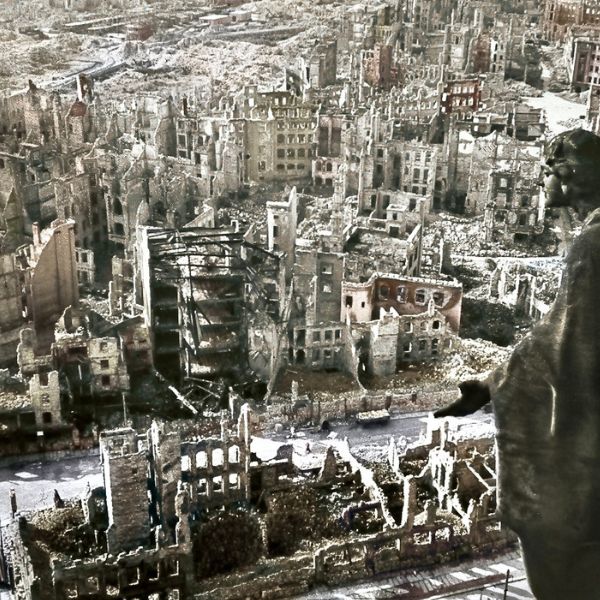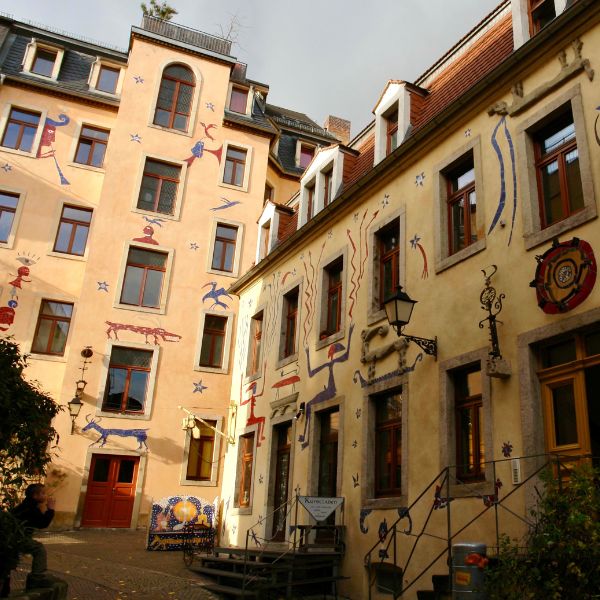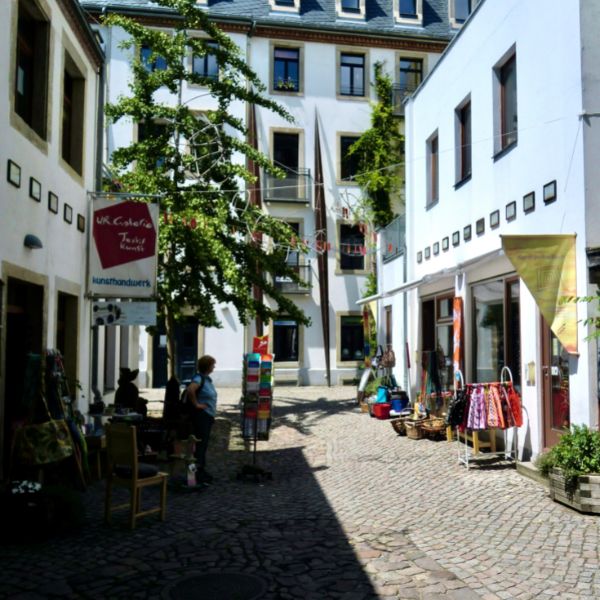Warm up this winter with Oma's newest cookbooks - available on Amazon >>
Attractions to see in Dresden: Uncover the Hidden Gems
By: Eran Fulson / Traveler, writer, and curious observer of all things German.
Steeped in culture, there are plenty of attractions to see in Dresden. German and Slavic traditions inundate this picturesque city, while streets filled with Baroque architecture look like snapshots from a postcard.
Huddled in the eastern part of Germany, close to the borders of Czechia (Czech Republic) and Poland, lies the capital of the state of Saxony - Dresden.
Derived from an old Sorbian dialect, Dresden roughly translates to “People from the forest by the river". Can’t fault it – they were a bit more literal in their descriptions back then.
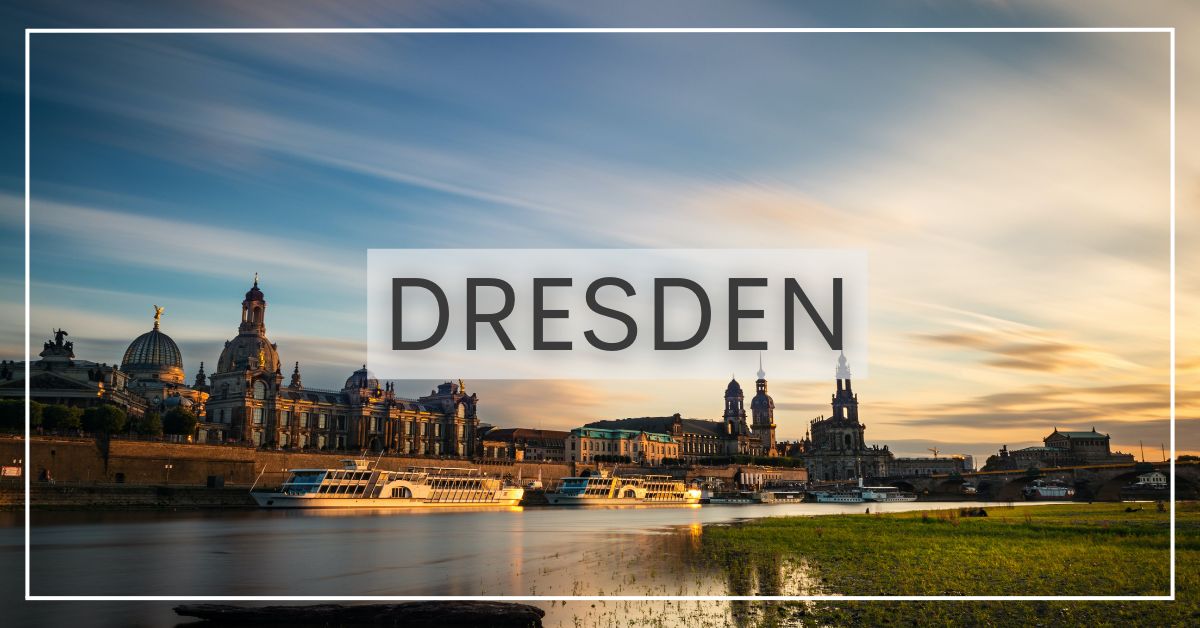
On this page:
It is worth noting that this is a city that almost never was, or at least never was anymore. During the final months of the Second World War, Dresden faced one of the most intense and controversial Allied bombing raids.
Nearly 2,700 tons of explosives were dropped and virtually leveled the German city.
Intended to strike fear into the civilian population, the Dresden bombing undoubtedly did just that.
However, from the ashes, Dresden was rebuilt in the years and decades that followed. During the reunification of Germany, buildings with cultural and historical significance were restored brick-by-brick as they once were.
The restoration is visually apparent everywhere you look. The multi-colored stonework in the old buildings is a result of the dark stones being the original and the lighter stones filling in the literal gaps.
Planning your trip
Getting There
Getting you to and from the many attractions to see in Dresden is meticulously planned infrastructure. So much so, it’s easy to access via any mode of transportation.
Flying into Dresden Airport (DRS) will bring you only 5.5 miles from the city center. There is one train and two bus lines that can take you in, and the journey is roughly twenty minutes.
Travel tips
While on the autobahn, it is illegal to run out of gas. This is seen as a preventable situation that results in stopping on the autobahn, which is also illegal.
If you’re arriving by car and feeling the need for speed, there are three autobahns that converge on Dresden coming in from Cologne, Bautzen, and Berlin.
There are also multiple free parking lots throughout the city. It's easy to check online where, and how full, they are.
Dresden Central Station is the main train station in the city, with links to many major German and European cities several times a day. The station itself has undergone extensive renovations over the years and is impressive in its own architectural prowess.
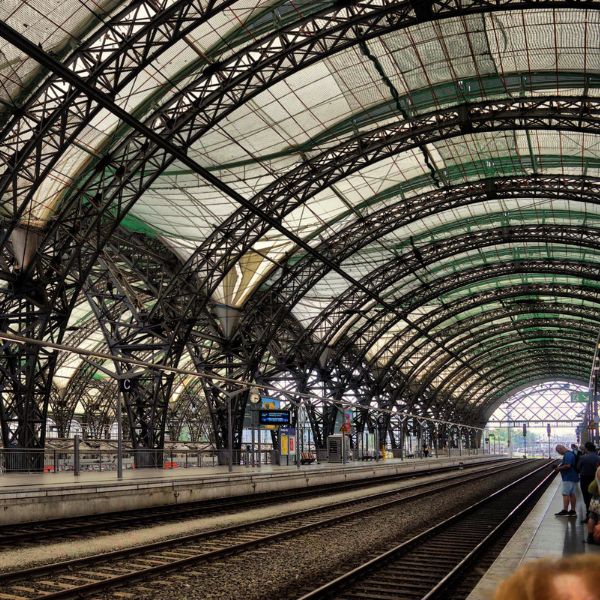
Buses, both getting to and around the city, are well-connected and, in many cases, the most affordable method of travel.
Once you’re in town, the Dresden City Card offers easy access to the public transportation network as well as discounts on many cultural and dining experiences.
Staying There
We've partnered with Stay22 to help streamline your holiday booking experience. Using the interactive map below, find your next home away from home.
Zwinger Palace
The art of subtlety is a lesson gone awry here. Pass through a crowned gate to the manicured courtyard and fountains before the grandeur of Zwinger Palace comes into view.
The queen bee of attractions to see in Dresden, its ornate architectural style of the Baroque period emanates from every corner.
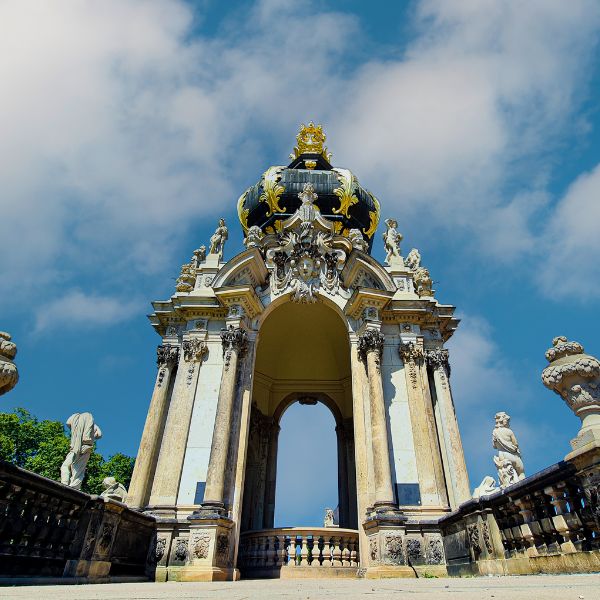 Amazing from a distance and majestic up close.
Amazing from a distance and majestic up close.The King of Poland, Augustus II, commissioned the palace courtyard in 1709 as an orangery and festival grounds. Though largely destroyed in World War II, an extensive restoration saw it brought back to its former glory.
Within its walls are several museums and world-famous art collections, including pieces by Raphael and Rembrandt.
The Gemäldegalerie Alter Meister (Old Masters Picture Gallery) contains more than 700 paintings, while the Porzellansammlung (Porcelain Collection) houses nearly 20,000 Chinese, Japanese, and Meissen porcelain artifacts.
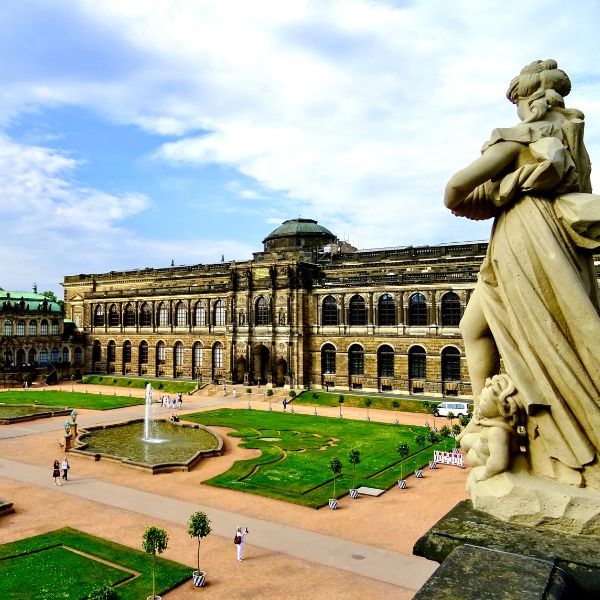 Keeping an ever-watchful eye on things.
Keeping an ever-watchful eye on things.Castle vs Palace
Pillnitz Pałace stands where Pillnitz Castle once held its ground, along the tranquil banks of the Elbe River.
The term “castle” in its common usage is attributed quite loosely here, as the site was originally a quaint residential fortress in the early 14th century.
Check out Lydia's post on the difference between a castle and a palace for a bit more clarity on the subtleties.
Augustus the Strong transformed the estate into a riverside playground for the wealthy during the early 1700s. Merry-go-rounds and amusement areas dotted the palace grounds, where nobles would indulge their inner child.
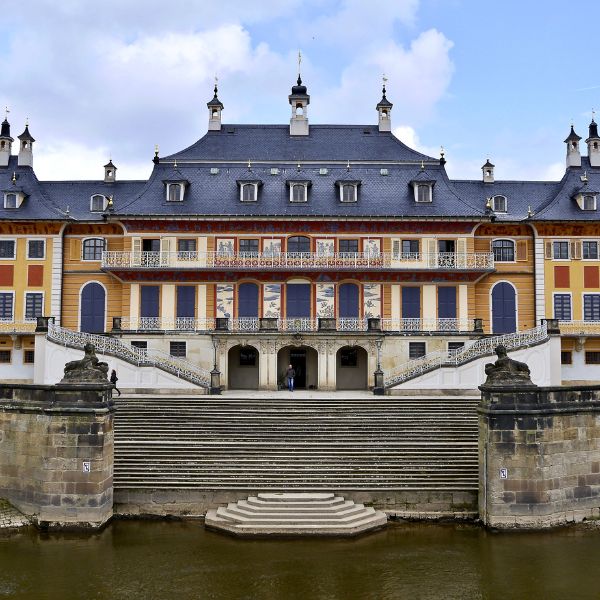 Watch your step.
Watch your step.Augustus later developed two more palaces: The Riverside Palace, with the impressive Monumental Staircase leading down to the water’s edge, and the Hillside Palace.
The central Renaissance Palace burned down in 1818 and was replaced by the New Palace (a fitting, if uninspired, name).
This noble summer residence estate embodies Baroque, Rococo, and Chinoiserie styles.
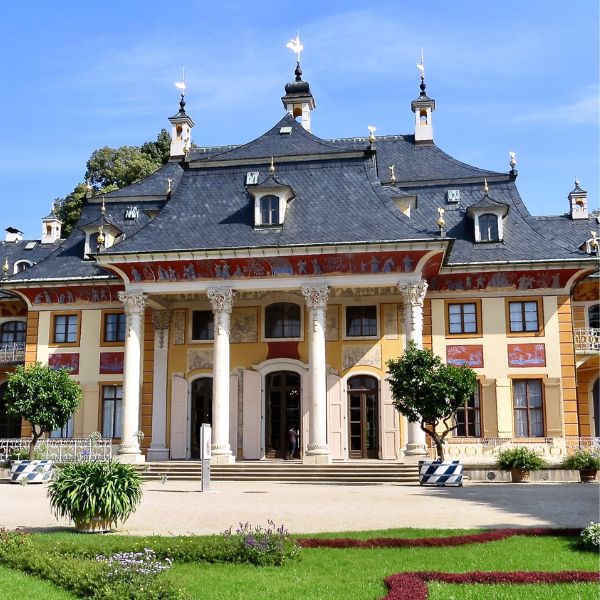
Dresden Castle, aka Royal Palace
Like nearly all of Dresden, the Royal Palace was almost completely destroyed during the Second World War. Fully restored, it contains one of the largest art collections in Europe, the Staatliche Kunstsammlungen Dresden (Dresden State Art Collections).
If you're a bit of a history buff, then of all the attractions to see in Dresden, this is the one to visit.
It’s best to set aside a bit of time to work your way through all the exhibits.
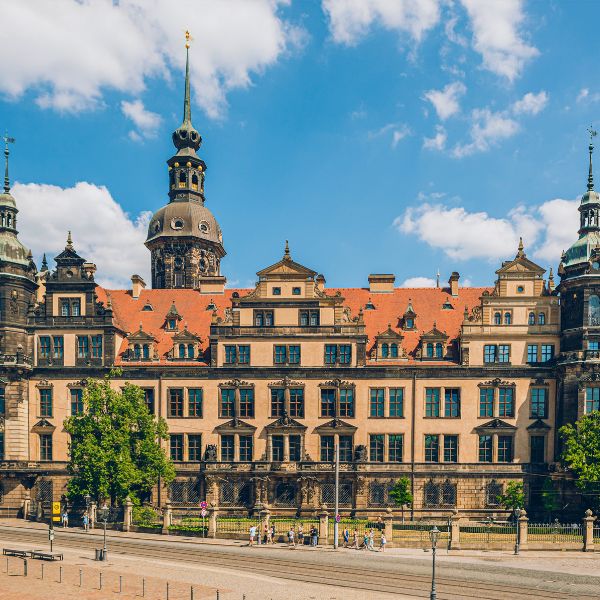
The Grünes Gewölbe (Green Vault) and the New Green Vault: filled with precious stones, gold, silver, and the largest green diamond ever discovered, among a trove of other treasures.
interesting info
The Royal Palace also holds another famous distinction: In 2009, it was the target of the largest bank robbery in modern history ($130 million). Don’t get any ideas though. The thieves have since been caught, and the majority of items were recovered.
The Kupferstich-Kabinett (Cabinet of Prints, Drawings, and Photographs): Over half a million printed works by more than twenty thousand artists.
The Rüstkammer (Armory): Fairly self-explanatory, however, don’t let the simplicity of the name put you off. On display are nearly thirteen thousand individual pieces of ceremonial weapons, armor, and costumes. This collection is one of the world's largest and most valuable of its kind.
Muenzkabinett (Coin Cabinet): The pinnacle of a hobbyist’s fortress of solitude. Also taking the crown among Dresden’s oldest museums, there are some three hundred thousand coins in its collection and more than three thousand exhibits on display.

Outside of the palace is where you’ll find, in no small expression, the Procession of Princes.
A three hundred-and-thirty-foot-long mural depicts a cavalcade of kings, artists, scientists, peasants, and horses.
Wilhelm Walther created the masterpiece with a plaster scratching technique. However, the elements deteriorated the plaster so badly that in 1907 it was renewed with twenty-three thousand tiles of Meissen porcelain.
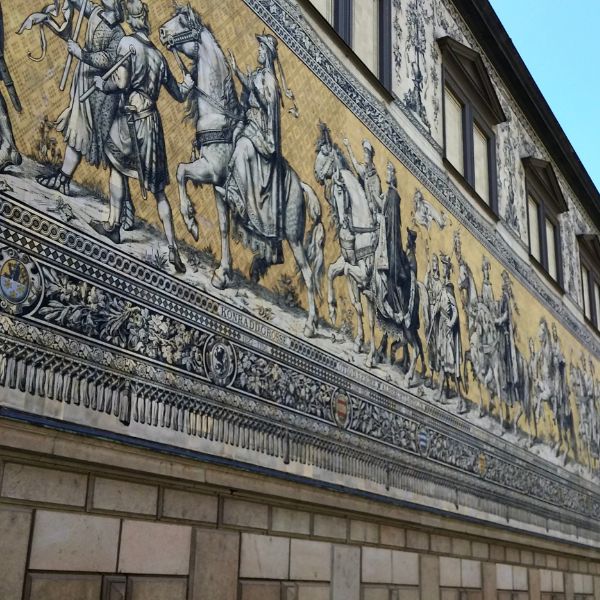
Once you’ve seen everything on the ground (I mean, it’s possible..?), head up to the viewing platform of Hausmann Tower for a bit of the Dresden panorama.
Bear in mind that it is three hundred and thirty feet tall and has no elevator. The views are worth it though, so take a breath before setting off.
Churches
Dresden Cathedral
One of the most notable landmarks in the city is the Dresden Cathedral, known more formally as Kathedrale Sanctissimae Trinitatis (Cathedral of the Holy Trinity).
It’s hard to miss this beautiful statement of Baroque architecture with its 18th-century spire overlooking the city.
Though badly damaged in the bombing of Dresden during World War II, it was given cathedral status in 1964 when restoration work was completed.
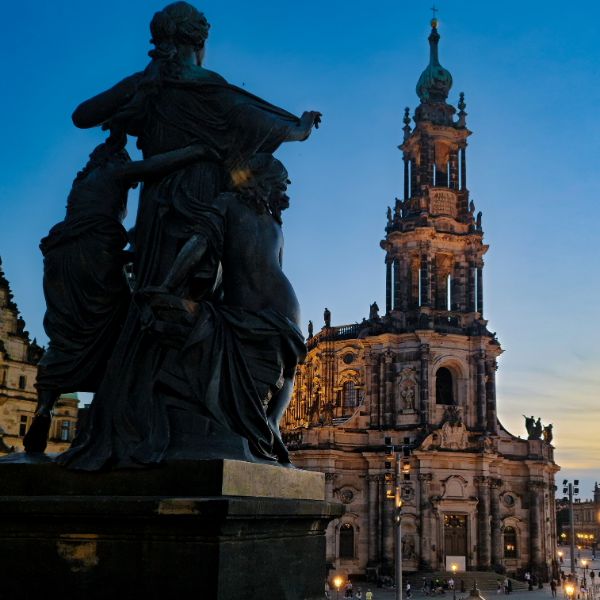 Evenings in Dresden are truly special.
Evenings in Dresden are truly special.Frauenkirche
At first glance, you wouldn’t guess Dresden’s original church, Frauenkirche (Church of Our Lady), was virtually destroyed during the Allied bombings in 1945.
After the war, citizens organized and cataloged stones from the rubble for its future reconstruction.
The work finally commenced in January 1993 and, using the original building plans from the 18th century, was reconsecrated in October 2005.
Today, it's one of the most recognizable landmarks and among the most beautiful attractions to see in Dresden.
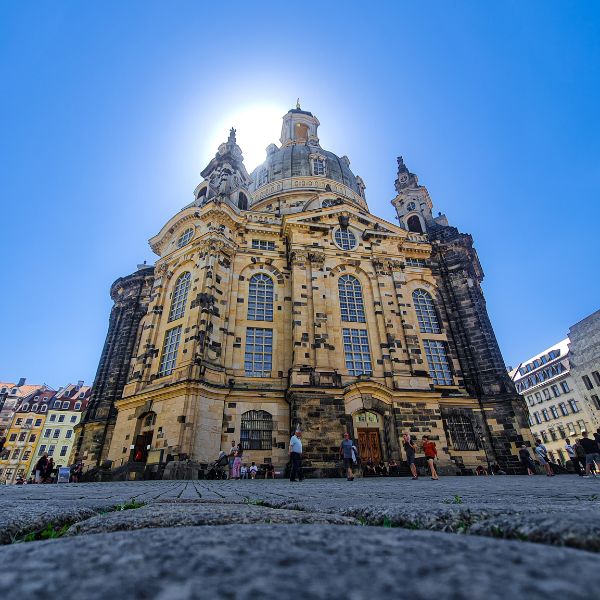 One of my favorite views in Dresden.
One of my favorite views in Dresden.In a fitting homage, this Lutheran church is adorned with a gold cross built by the son of a British bomber pilot who took part in the city’s destruction.
The massive, twelve thousand-ton sandstone dome is undoubtedly the first grand impression walking up to the church. From within, it’s even more spectacular. On the way up to the lantern above the dome, there is an impressive birds-eye view of the church interior.
Carry on up to a height of two hundred and twenty feet to a viewing platform with panoramas of the Elbe Sandstone Mountains in the east and the Ore Mountains to the west.
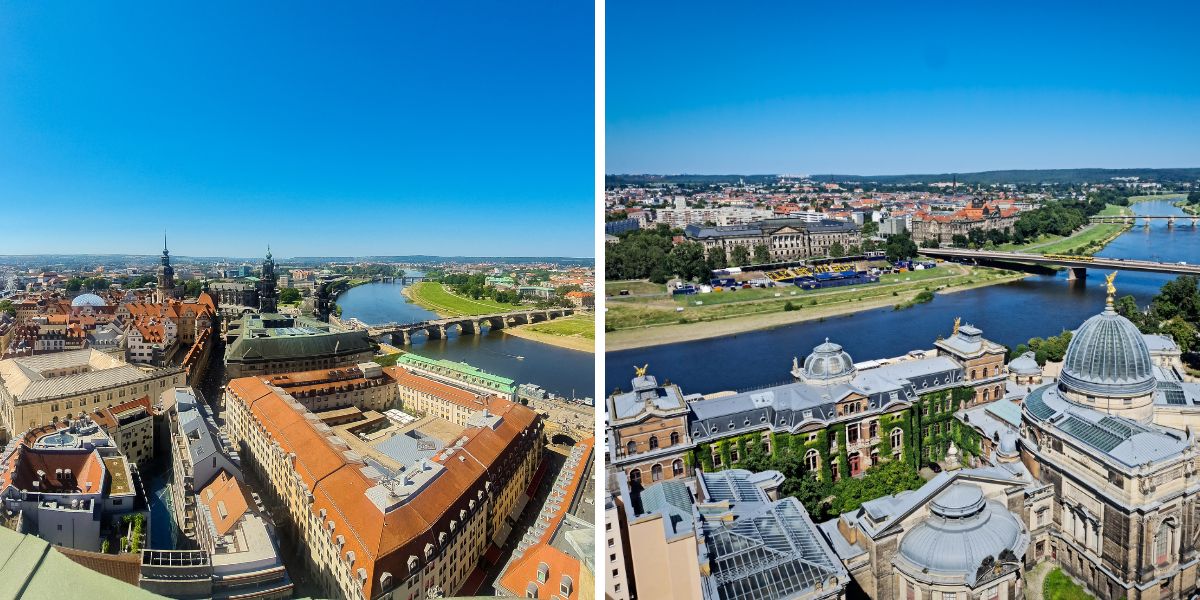 It's a bit of a trek up the tower, but worth it for the views.
It's a bit of a trek up the tower, but worth it for the views.The Semperoper
The history of the first Dresden opera house opening its doors stretches back to 1667. One hundred and fifty years of operatic prominence led to architect Gottfried Semper building the Semperoper.
After a fire destroyed the opera house in 1869 and again in the Dresden bombings in 1945, it was rebuilt in 1985. So far, the third time’s the charm.
Today, it is the most famous opera house in Germany along with the world's oldest orchestra, the Saxon State Orchestra.
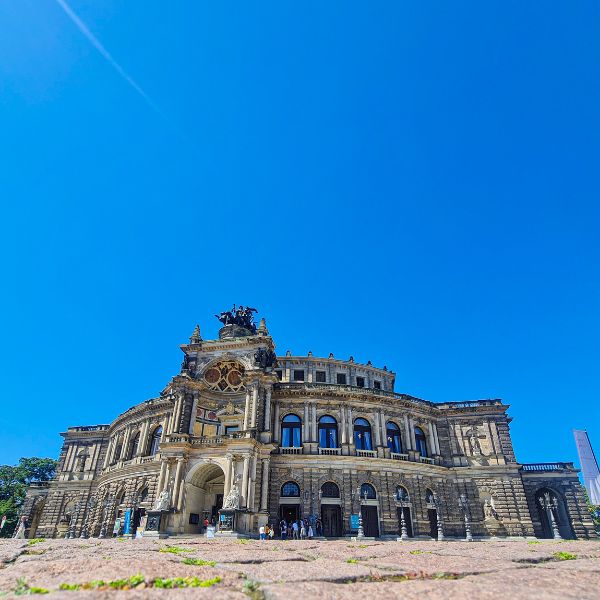
Brühl's Terrace
Along the banks of the Elbe River is the architectural ensemble of Brühl's Terrace. Known as the Balcony of Europe since the 19th century, the nickname hasn’t lost any of its luster over the years. This is truly one of the top attractions to see in Dresden, with a spectacular display of architecture.
Among the collection of buildings are the Saxony Supreme Court, the Academy of Fine Arts, the Albertinum (a modern art museum), and the Sächsisches Ständehaus (Saxon House of Estates).
The terrace was named after Count Heinrich von Brühl, who had the land given to him after introducing a betterment tax on the citizens of Dresden. It wasn’t until nearly seventy years later, when Russian troops occupied the city, that Prince Nikolai Grigorjevich Repnin-Wolkonski opened the terrace to the public.
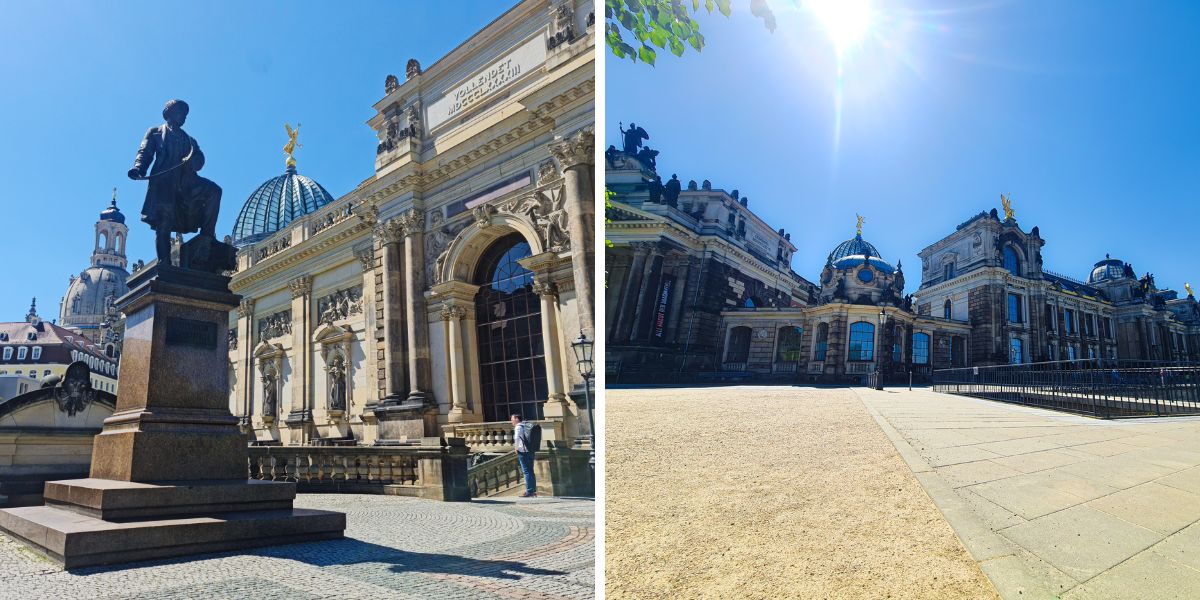
These days, it is one of the top tourist attractions in Dresden and a great place to walk and relax along the river.
Dresden Neustadt
I’ll admit it, the focus of these articles tends to lean into the historical side of Germany. And that’s because there is history everywhere you look—original and rebuilt. It is stunningly beautiful, and there is no escaping it.
However, not only is time marching on, but it also brings a renewed breath of creativity and spirit. Enter stage left, Dresden Neustadt, and specifically, Innere Neustadt (Inner New City).

In a shift from the typical architectural prowess of the top attractions to see in Dresden, Neustadt is attractive in its own right.
A new era of cultural vibrancy permeates the narrow, winding streets and cafes dotted throughout the district.
While counter-culture might be the underlying theme here, a welcoming atmosphere greets you through the doors of quirky cafes and handicraft shops.
If I’ve given the impression this area is all a modern addition, apologies, the Inner New City was actually rebuilt in 1685 after a fire destroyed the district. This area is also one of the few that survived largely intact during the Second World War air raids.

All right then, diving in… please forgive me for not telling you exactly how to arrive at Kunsthofpassage (Art Courtyard Passage). Ambiguity is prevalent here, and it's best to entrust a resident/taxi to get you close. It’s a bit off the beaten track, and that’s all the more reason to find it.
Kunsthofpassage refers to a series of five small courtyards located in an area known as the “student district”. In 2001, a group of artists and sculptors redesigned the building's facades and courtyards to create a visual cacophony of imagination and creativity.
One of the most well-known spaces in this collective is the Hof der Elemente (Courtyard of Elements). The building’s downpipes, on the eye-catching blue house, flow seemingly at random down the facade and become musical instruments that play when the rain falls.
A visit best saved for a rainy day.
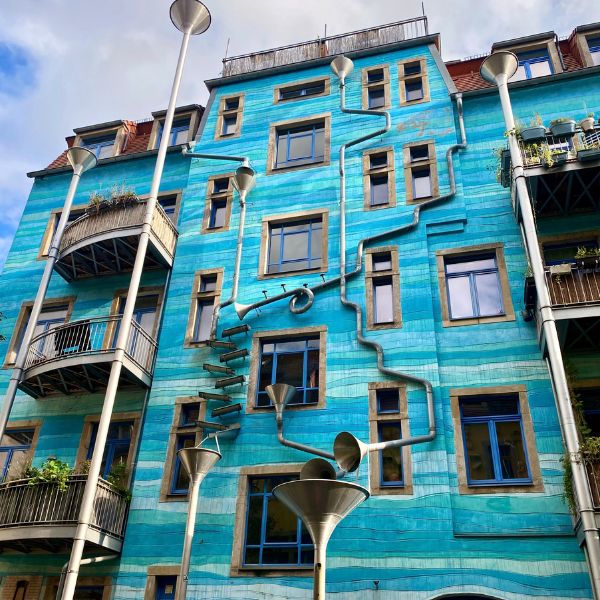 Singing in the rain - literally.
Singing in the rain - literally.The Hof des Lichts (Courtyard of Light) is perhaps the most understated at first glance.
Two stages and multiple projection surfaces for live and digital performances give this courtyard a lively vibe at night.
In the daytime, the area is illuminated by various metallic mirrors that cast colored reflections as they catch the sun moving throughout the day.
Hof der Fabelwesen (Courtyard of Mythical Creatures) is as self-explanatory as they come. Artist Viola Schöpe covered the buildings in modern-day hieroglyphics as she attempted to bridge the gap between the mythological and material.
The crisp surroundings of Hof der Metamorphosen (Courtyard of Metamorphoses) house several handicraft and textile shops. As the daylight fades, numerous shields lining the courtyard change from the inauspicious to an illumination that redefines its surroundings.
The Hof der Tiere (Court of Animals) is the last in this walking tour of street art. A static zoo of sorts that likens to walking through a storybook from childhood.
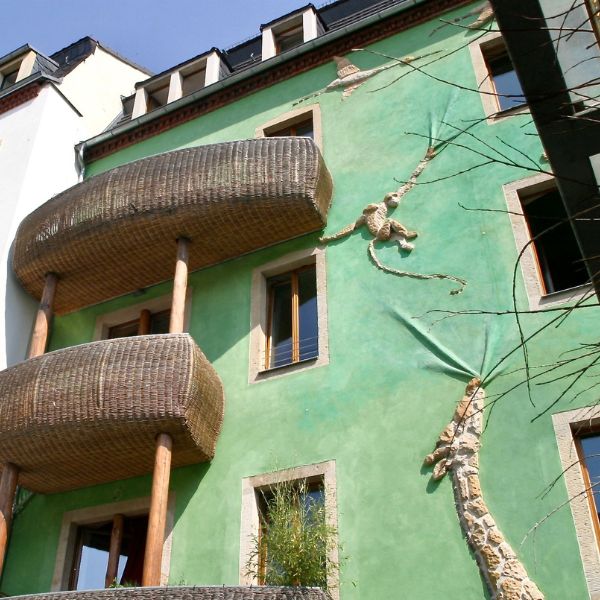
I’d be remiss not to mention that, like the rest of Dresden, there is a wedge of notable history in the Neustadt district as well.
The Japanisches Palais (Japanese Palace) along the Elbe River was established in the early 1700s by Augustus the Strong to display his Japanese porcelain collection, which is now in the Dresden Porcelain Collection.
The palace was established in 1786 as a museum complex, with the Senckenberg Natural History Museum and the Museum of Ethnology currently housed within.
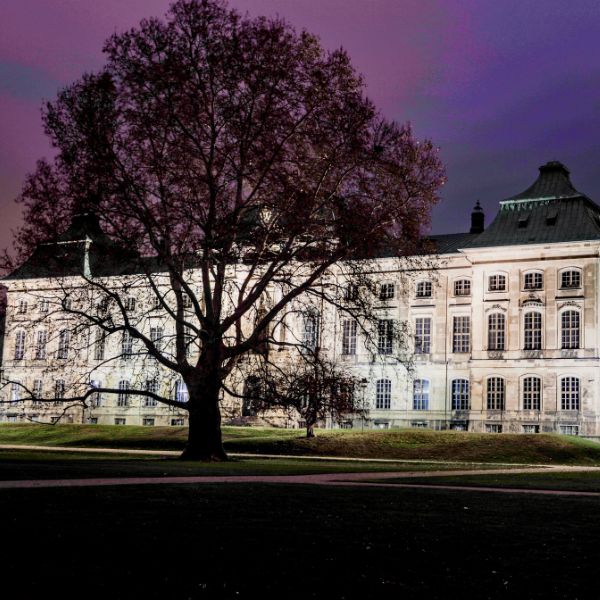
Out and about
Loschwitz Bridge
The Loschwitz Bridge, also known as the Blue Wonder, was an engineering marvel back in 1893.
It is the oldest bridge in Dresden and a notable landmark between the affluent Blasewitz and Loschwitz districts.
At the time, it was highly unusual for a cantilever bridge to span over five hundred feet between piers. A more common sight these days, but nevertheless, an impressive feat for the time.

Saxon Switzerland National Park
If you don’t own a pair of hiking boots, you’re going to want to for this one. A short drive from Dresden, the Saxon Switzerland National Park undoubtedly has one of Europe’s most spectacular natural landscapes.
Breathtaking sandstone formations coexist with dense woodland and a diverse ecosystem of plants and animals.
Though no relation to Switzerland, the park's name derives from the early explorers comparison with the Swiss landscape.
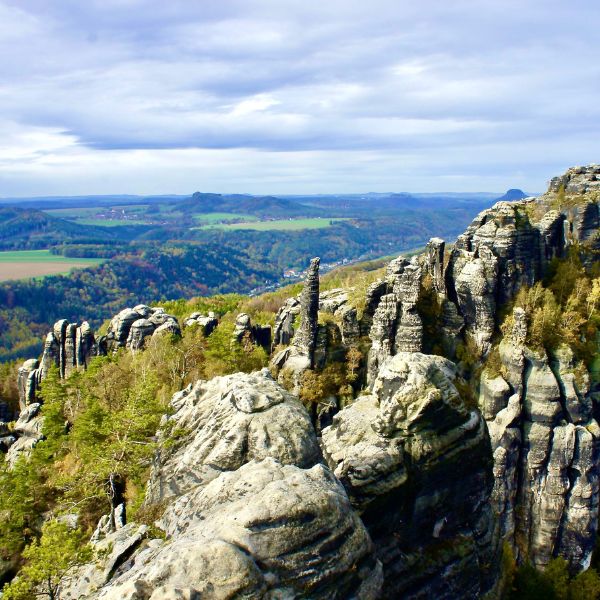
The most impressive of the sandstone formations are the Bastei. So much so that it’s been a tourist destination for the past two hundred years.
Spanning several giant pinnacles of natural sandstone towers is the Bastei Bridge.
Originally made out of wood, it was replaced by a stone bridge in the mid-1800s that stands today. The view across the Elbe Sandstone Mountains, river valley, and sprawling forests is a beautiful panorama you would be hard-pressed to compare.
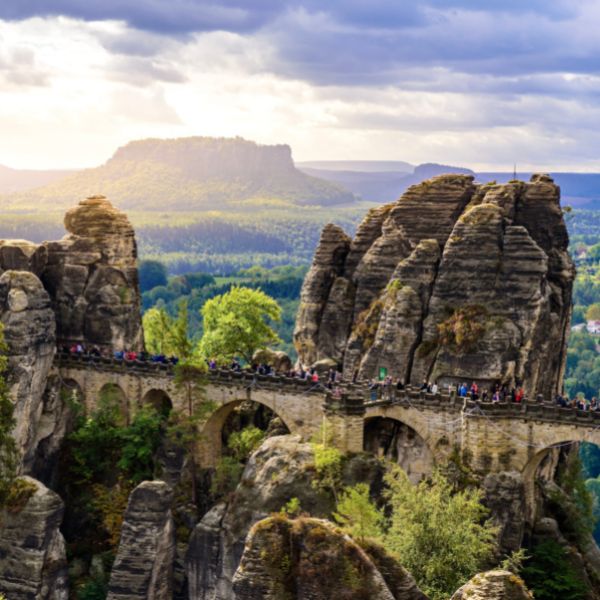
Christmas Markets
There are several markets dotted throughout the city.
Ranging from the more traditional markets at the Frauenkirche and Stallhof Advent Festival at the Royal Palace to the newer Augustus Market with fairground rides, and the quietly Romantic Christmas Market with an outdoor ice rink in the hotel courtyard.
However, the one at the top of the list is…
Striezelmarkt
historical Facts
‘Striezel’ refers to a cake sold at the market which is now widely known as Stollen - first created in Dresden and thought to have originated in 1329.
It wouldn’t be Christmas without wandering around a quintessential German market now would it? And where better than one of the oldest Christmas markets in the world?
One of the top attractions to see in Dresden dates back to 1434 when a market was established to provide the people of Dresden with the meat they would need for their Christmas meal. Now, nearly 600 years later, the Dresden Striezelmarkt boasts 240 stalls serving around 3 million visitors during the festive season.
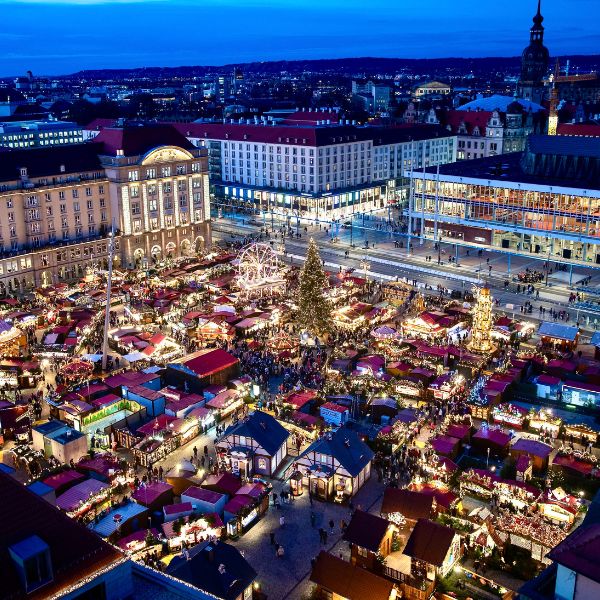
Food and Drink
Saxon cuisine leans heavily into the hearty category from its traditional beginnings of keeping miners sustained through the long days.
While the mining may have ended, the food keeps on going. Alongside slow-cooked beef and potato dumpling dishes, you’ll find a variety of fish from main rivers like the Elbe and Weser.
Must-try desserts would be the Eierschecke, a layered cheesecake and one of the city's most beloved originals. And of course, Stollen, a true German classic.

A hearty meal is best quenched with the local Radeberger Pilsner. Brewed in Radeberg since 1872, between Dresden and the Elbe Valley, this beer is one of Germany’s favorite pilsners and often the first choice when welcoming foreign dignitaries.
Final Thoughts
The many attractions to see in Dresden are a result of its unique blend of German and Saxony cultures owing to its location near Poland and Czechia.
The landscape as you look beyond the city is simply stunning and worthy of a few photos along your journey.
A youthfulness in the atmosphere mixes with the history underfoot, making this city a desirable place to stay for however long you choose.

When was Dresden established?
When was Dresden established?
Dresden was established in 1206 A.D.
What is the land area of Dresden?
What is the land area of Dresden?
126.7 sq mi
What is the population of Dresden?
What is the population of Dresden?
555,351 (Dec. 2021)
What is the GPS location of Dresden?
What is the GPS location of Dresden?
What are the closest major cities to Dresden?
What are the closest major cities to Dresden?
Chemnitz 38.5 mi
Leipzig 63 mi
Prague, Czechia 74 mi
Berlin 102.5 mi
Nuremberg 160 mi



